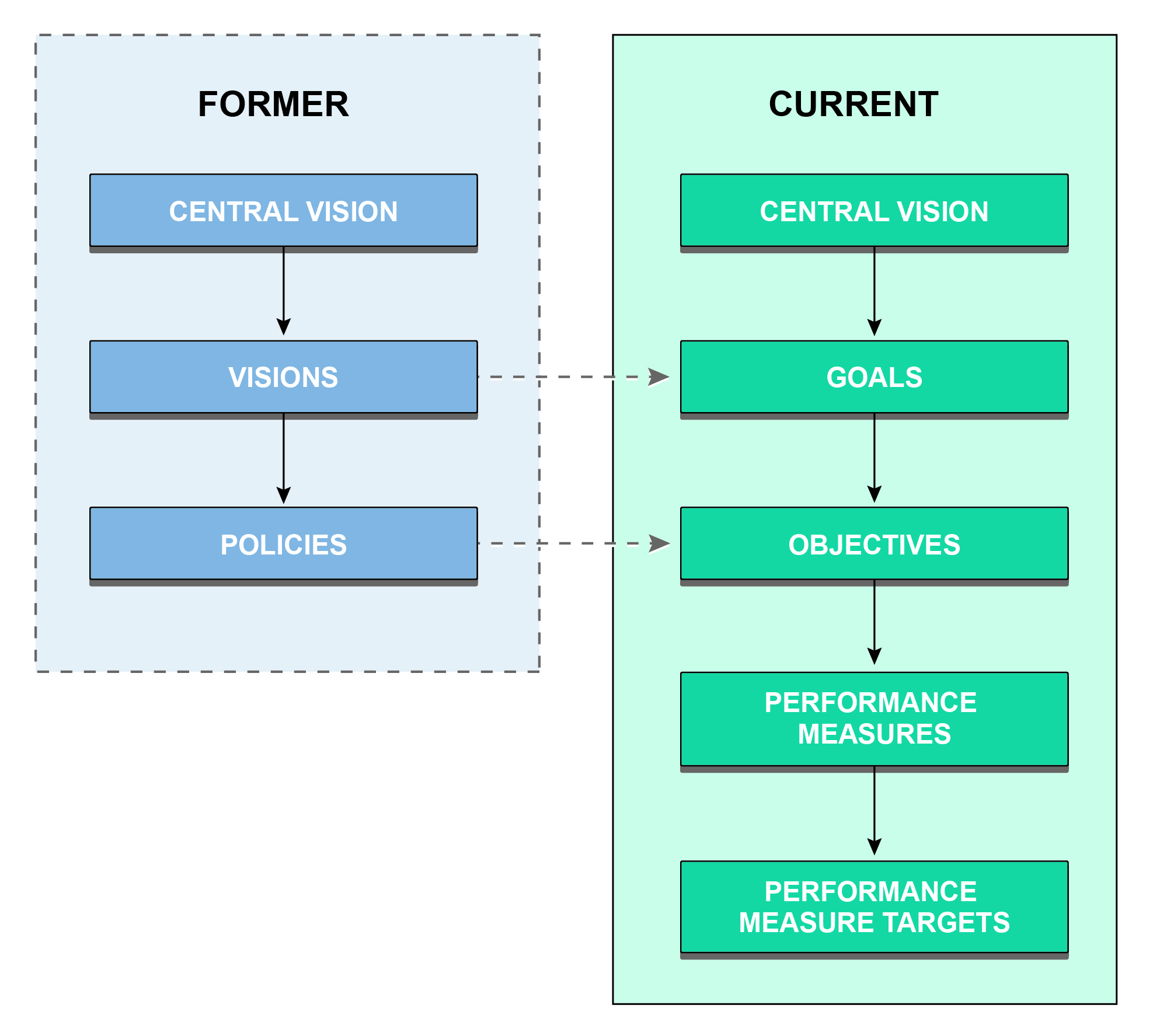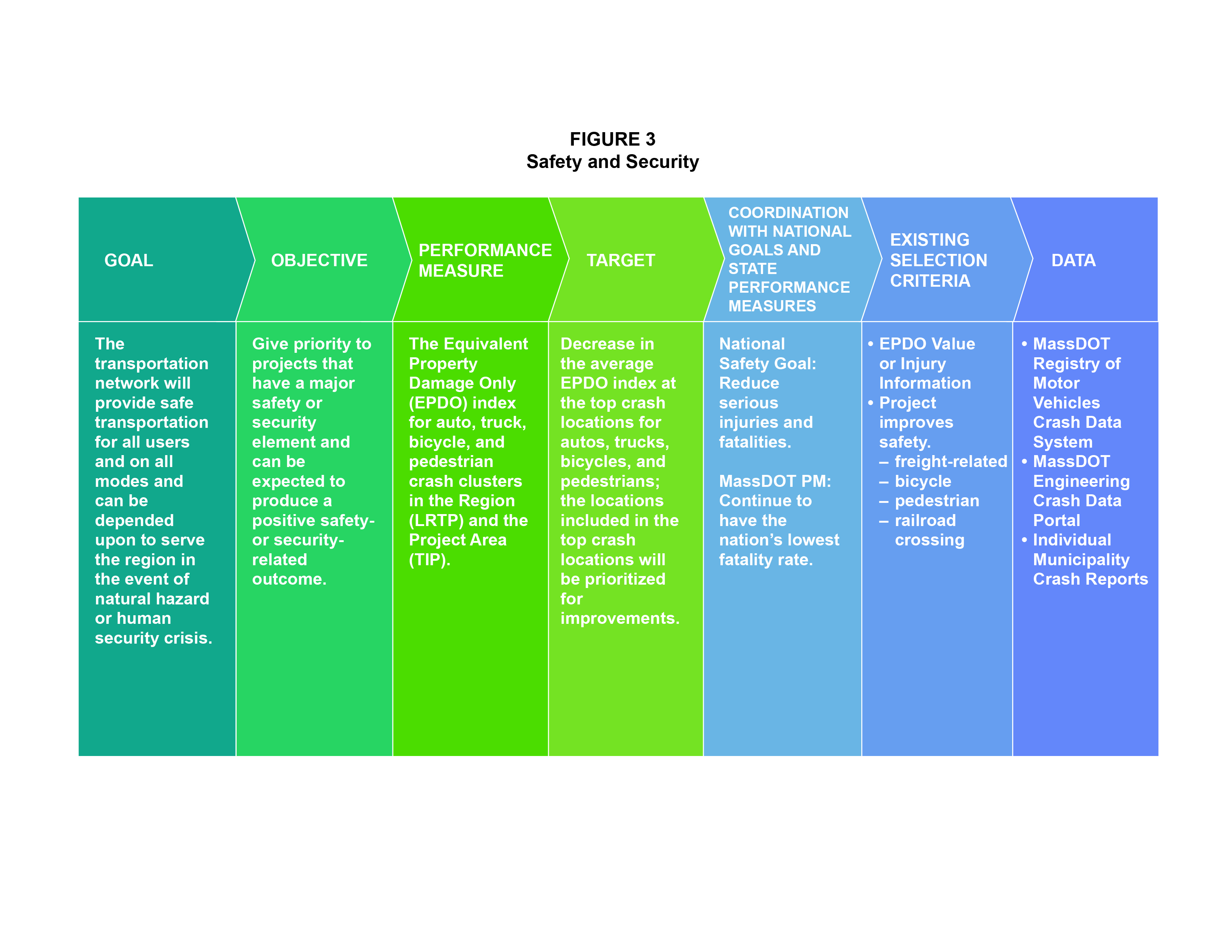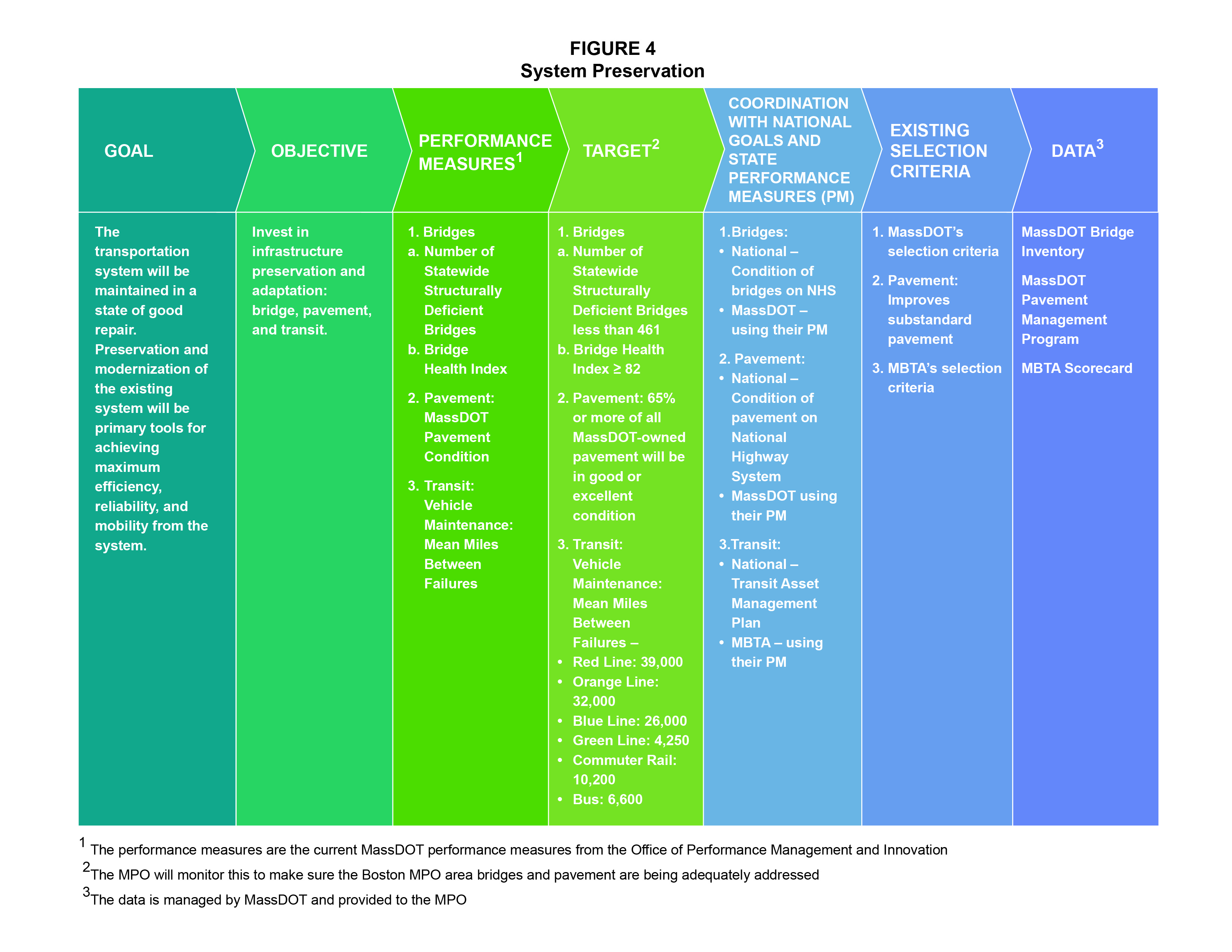
Memorandum
Date: February 20, 2014
To: Boston Region Metropolitan Planning Organization (MPO)
From: Anne McGahan, MPO Staff
Re: Performance Measures — Goals and Objectives and Additional Framework
The memorandum Next Steps in the Development of Performance Measures was presented to the Boston Region MPO at its December 5, 2013 meeting. That memorandum examined next steps in the development of MPO performance measures as they relate to the Boston Region MPO’s current visions and policies. It also provided detail about specific national requirements for performance measures and included updates on MassDOT’s own performance-based planning.
In that memorandum, staff recommended that the Boston Region MPO refine its visions and policies to create a foundation consistent with the new MPO responsibilities in performance-based planning required in the Moving Ahead for Progress in the 21st Century (MAP-21) federal legislation. Because the essence of the federal legislation is about performance, staff recommended that the MPO’s visions and policies be distilled and finely focused on performance; and further, that they be referred to as Goals and Objectives, which are concepts in line with federal terminology. The memorandum also included an example of how this would be done using the MPO’s Safety and Security vision and policies.
This present memorandum outlines staff recommendations for the additional goals and objectives that were distilled from the MPO’s current visions and policies. It also provides further detail and examples of ways the goals and objectives would be used to develop performance measures and targets; and how performance will be tracked, coordinated with state and national goals, and used in the MPO’s project-selection criteria.
Following the presentation of the proposed next steps for developing performance measures at the December 5, 2013 MPO meeting, it was agreed that staff would continue to develop the goals, objectives, performance measures, and targets for the remaining themes:
Figure 1 provides the MPO’s current vision and policy statements along with staff recommendations for converting these visions and policies into goals and objectives for each theme following the process shown in Figure 2 below. In developing the recommendations, staff sought to extract the essence of the original vision statement and express it as a measurable outcome. In addition, staff sought to use direct, clear, and uncomplicated language.
Staff applied this approach to the development of recommended objectives, as well. Not every original vision or policy item is explicitly carried forward into the recommended goals and objectives. However, this simplified process includes, often implicitly, all the basic ideas the MPO originally envisioned; the goals and objectives are simply less prescriptive and more focused on outcomes that the MPO can directly target. The Safety and Security goal and objective that were included in the previous memorandum are shown here along with the new recommended ones.
3 Proposed Performance Measures and targets
As shown in Figure 2, the next step is to develop performance measures and targets for each goal and objective. Staff presented a performance measure and target for the Safety and Security goal and objective in the December 5 memorandum and showed how that performance measure would be tracked through the MPO’s certification documents and how it corresponds to national goals and state performance measures.
Staff presents the Safety and Security information again in this memorandum with additional information that shows how the existing Transportation Improvement Program’s (TIP) project selection criteria will be tied into the process. This information is shown in Figure 3. A performance measure for the System Preservation goal and objective is also presented in Figure 4, which shows how the System Preservation performance measure will correspond to national goals, state performance measures, and the MPO’s project-selection criteria.
FIGURE 1
Linking Original MPO Visions and Policies to Proposed MPO Goals and Objectives
SAFETY AND SECURITY VISIONS TO GOAL
Safety and Security Related Visions from Original MPO Visions |
GOAL |
The transportation system provides safe transportation (personal and operational) on all modes (Safety and Security Vision) |
The transportation network will be safe for all users on all modes and can be depended upon to serve the region in the event of a natural hazard or human-security crisis. |
The number and severity of crashes are reduced (Safety and Security Vision) |
|
The viability of transportation infrastructure critical to emergency response and evacuations is protected from natural and man-made threats (Safety and Security Vision) |
|
Transit has state-of-the-practice intelligent transportation systems (ITS) and communication systems; transit malfunctions are reduced (Safety and Security Vision) |
SAFETY AND SECURITY POLICIES TO OBJECTIVE
Safety and Security Related Policies from Original MPO Policies |
OBJECTIVE |
Implement actions stemming from all-hazards planning (Safety and Security Policy) |
Give priority to projects that have a major safety or security element and can be expected to produce a positive safety- or security-related outcome. |
Maintain the transportation system in a state of good repair (Safety and Security Policy) |
|
Use state-of-the-practice safety elements; address roadway safety deficiencies (after safety audits) and transit safety (including federal mandates) (Safety and Security Policy) |
|
Support incident management programs and ITS (Safety and Security Policy) |
|
Protect critical infrastructure: address transit security vulnerabilities; upgrade key transportation infrastructure to a “hardened” design standard (Safety and Security Policy) |
|
Improve safety for pedestrians and cyclists; ensure that safety provisions are incorporated into shared-use corridors (Safety and Security Policy) |
|
Give priority to safety projects that reduce the severity of crashes, especially those that improve safety for all (Safety and Security Policy) |
|
Promote safety through supporting the reduction of base speed limit (municipalities) to 25 miles per hour; and education and enforcement on rules of the road, all modes) (Safety and Security Policy) |
SYSTEM PRESERVATION VISIONS TO GOAL
System Preservation Related Visions from Original MPO Visions |
GOAL |
System is maintained in state of good repair (SGR) (System Preservation Vision) |
The transportation system will be in a state of good repair. Preservation, modernization, and innovation will be the primary tools for achieving maximum efficiency, reliability, and mobility. |
System achieves maximum efficiency, reliability, and mobility (regionwide) through system preservation, ITS, technology, management and operations (M&O) programs, and a balanced program of strategic investments (System Preservation Vision) |
|
Innovative approaches reduce auto dependency and actively promote other modes (System Preservation Vision) |
|
Modernization of the existing system provides accessibility and access for all; serves more people (System Preservation Vision) |
SYSTEM PRESERVATION POLICIES TO OBJECTIVE
System Preservation Related Policies from Original MPO Policies |
OBJECTIVE |
Adapt to fiscal constraints by developing needs-based, low-cost strategies for addressing mobility, access, and accessibility and by pursuing alternative funding sources and mechanisms (System Preservation Policy) |
Invest in infrastructure preservation and adaptation: bridge, pavement, and transit. |
Put a priority on programs, services, and projects that maximize efficiency through ITS, technology, TSM, and M&O; turn to technology before expansion (System Preservation Policy) |
|
Bring and keep the network (particularly the transit, bike, and pedestrian facilities) into an SGR; set funding objectives for this (System Preservation Policy) |
|
For roadway investments, give priority to maintaining regional network of bridges and roads (System Preservation Policy) |
|
The MPO supports increased Chapter 90 funding from the state so that local road maintenance can remain focused on that program (System Preservation Policy) |
CONGESTION REDUCTION VISIONS TO GOAL
Congestion Reduction Related Visions from Original MPO Visions |
GOAL |
System provides reliable service; delays, congestion, and travel time are reduced (Mobility Vision) |
There will be a reduction in congestion and delays for all modes. |
Transit ridership and use of sustainable options are increased (Mobility Vision) |
|
Existing transit, bicycle, and pedestrian facilities are linked in a network (Mobility Vision) |
|
Expansion comes through strategic investments, based on regional needs assessment (System Preservation Vision) |
CONGESTION REDUCTION POLICIES TO OBJECTIVE
Congestion Reduction Related Policies from Original MPO Policies |
OBJECTIVE |
Improve transit frequency, span, and reliability (Mobility Policy) |
Increase capacity on transit and non-motorized modes and reduce congestion at bottlenecks for all modes. |
Expand transit, bicycle, and pedestrian networks; focus bicycle investments (lanes and paths) on moving people between activity centers (and access to transit) (Mobility Policy) |
|
Support TDM, TMAs, shuttles, and carpooling (Mobility Policy) |
|
Address low cost capacity constraints and bottlenecks in the existing system before expansion (Mobility Policy) |
|
Give priority to heavily used transit services over new, yet-to-be-proven services (Regional Equity Policy) |
TRANSPORTATION OPTIONS/MODE SHARE VISIONS TO GOAL
Transportation Options/Mode Share Related Visions from Original MPO Visions |
GOAL |
System provides improved access to jobs; education and training; health services; social and recreational opportunities (Mobility Vision) |
The majority of residents will have access to transit and non-motorized (healthy) transportation options. There will be an equitable level of mobility for traditionally underserved populations. |
There are more transportation options and accessibility for all; all modes (including freight); all corridors (Mobility Vision) |
|
System provides reliable service; delays, congestion, and travel time are reduced (Mobility Vision) |
|
Transit ridership and use of sustainable options are increased (Mobility Vision) |
|
The system meets people’s needs; funding is guided by attention to customer service(Mobility Vision) |
|
Existing transit, bicycle, and pedestrian facilities are linked in a network (Mobility Vision) |
|
Land use policies and transportation investments give all residents the opportunity to move (affordably) between where they live, work, get services, and play, using healthy transportation options; promoting a healthy lifestyle (Livability Vision) |
|
Multimodal transportation serves business, residential, and mixed-use centers; investments focus on existing activity centers, where density will be encouraged (Livability Vision) |
|
Community centers thrive with implementation of complete streets and context-sensitive design (Livability Vision) |
|
Mobility for persons with disabilities is improved (Livability Vision) |
|
There is equitable mobility, quality, affordability, and access to jobs, educational institutions, and services for low-income and minority residents, the elderly, youth, and persons for whom English is a second language (Regional Equity Vision) |
TRANSPORTATION OPTIONS/MODE SHARE POLICIES TO OBJECTIVE
Transportation Options/Mode Share Related Policies from Original MPO Policies |
OBJECTIVE |
Strengthen connections between modes; close gaps in the existing network (Mobility Policy) |
Invest in transportation projects that improve the reliability of and expand access and connectivity to transit services and non-motorized (healthy) transportation options. Focus these investments on existing or planned activity or economic centers, consistent with MetroFuture; and consider transportation access and accessibility for underserved populations. |
Improve access and accessibility to transit (Mobility Policy) |
|
Improve transit frequency, span, and reliability (Mobility Policy) |
|
Expand transit, bicycle, and pedestrian networks; focus bicycle investments (lanes and paths) on moving people between activity centers (and access to transit) (Mobility Policy) |
|
Integrate payment methods for fares and parking across modes (Mobility Policy) |
|
Support TDM, TMAs, shuttles, and carpooling (Mobility Policy) |
|
Invest in projects and programs that are consistent with MetroFuture land use planning (serving already-developed areas; locations with adequate sewer and water; areas identified for economic development by state, regional, and local planning agencies; and density) (Livability Policy) |
|
Support health-promoting transportation options; expand and close gaps in the bicycle and pedestrian networks; promote a complete-streets philosophy (Livability Policy) |
|
Support urban and context-sensitive design to protect cultural, historic, and scenic resources, community cohesiveness, quality of life; fund enhancements at reasonable cost (Livability Policy) |
|
Support state-of-the-practice parking policies (Livability Policy) |
|
Continue outreach and analysis to identify equity needs; continue to monitor system performance (Regional Equity Policy) |
|
Address identified equity needs related to service and removing or minimizing burdens (air pollution, unsafe conditions, community impacts) (Regional Equity Policy) |
|
Track implementing agencies' actions responding to transportation needs identified in MPO outreach and analysis; encourage action to address needs (Regional Equity Policy) |
|
Strengthen avenues for involvement of low-income and minority persons in decision making (Regional Equity Policy) |
|
Reduce trip times for low-income and minority neighborhood residents and increase transit service capacity (Regional Equity Policy) |
GREENHOUSE GAS/AIR POLLUTANT REDUCTION VISIONS TO GOAL
Greenhouse Gas/Air Pollutant Reduction Related Visions from Original MPO Visions |
GOAL |
Greenhouse gas (GHG) emissions are reduced to Global Warming Solutions Act levels (Climate Change Vision) |
There will be improvements to air quality in the region and reduction of GHG emissions to Global Warming Solutions Act levels or below. |
The MPO has adopted GHG reduction goals and is acting to meet them (Climate Change Vision) |
|
Transportation infrastructure is protected (Climate Change Vision) |
|
Environmental burdens from transportation (existing and future) are minimized; low-income and minority populations are not inequitably burdened (Regional Equity Vision) |
|
Air quality is improved; vehicle emissions (carbon monoxide, nitrogen oxides, volatile organic compounds, carbon dioxide, and particulates) are reduced to required and/or target levels (Environment Vision) |
|
Energy use is managed efficiently and alternative energy sources are used (Livability Vision) |
GREENHOUSE GAS/AIR POLLUTANT REDUCTION POLICIES TO OBJECTIVE
Greenhouse Gas/Air Pollutant Reduction Related Policies from Original MPO Policies |
OBJECTIVE |
Take action to meet defined targets for reducing vehicle-miles traveled (VMT) (Climate Change Policy) |
Fund projects that reduce GHG and air pollutants. |
Pursue stronger land use and smart-growth strategies (Climate Change Policy) |
|
Tie transportation funding to VMT reduction (Climate Change Policy) |
|
Increase transit, bicycle, and pedestrian options (Climate Change Policy) |
|
Invest in adaptations that protect critical infrastructure (Climate Change Policy) |
|
Encourage transportation demand management (TDM) commuter strategies (Climate Change Policy) |
|
Invest in projects and programs for fleet management and modernization, idling reduction, alternative fuels (Climate Change Policy) |
|
Energy use will be part of the environmental impact analysis of all projects. Total energy use in the Plan will be (x%) less than 1990 transportation-related energy use in the MPO region (Climate Change Policy) |
|
Promote fleet management and modernization (Environment Policy) |
|
Support high-occupancy-vehicle travel options (Environment Policy) |
|
Protect natural and cultural resources and public health; plan early to avoid and mitigate impacts, such as stormwater and groundwater impacts, and air quality impacts, including introduction of additional fine particulates (Environment Policy) |
|
Promote energy conservation and use of alternative energy sources (Environment Policy) |
|
Avoid funding projects that increase exposure of at-risk populations to ultrafine particulates (Environment Policy) |
|
Promote investments and give priority to projects and programs with lower life-cycle costs and emissions (Environment Policy) |
|
Invest so as to increase mode share of transit and non-motorized modes (Environment Policy) |
|
Work with environmental and cultural resource agencies to reach environmental objectives (Environment Policy) |
ECONOMIC IMPACT VISIONS TO GOAL
Economic Impact Related Vision from Original MPO Visions |
GOAL |
The transportation system will play its part as a foundation for economic vitality (Livability Vision) |
The transportation network will provide a strong foundation for economic vitality. |
ECONOMIC IMPACT POLICIES TO OBJECTIVE
Economic Impact Related Vision from Original MPO Visions |
OBJECTIVE |
Use economic impacts (local and regional) as criteria for evaluating projects and programs; recognize that economic vitality plays a role in community livability (Livability Policy) |
Invest in infrastructure that will improve the flow of goods and delivery of services, including improvements for truck traffic flow and intermodal connections. |
FIGURE 2
Converting Visions and Policies to Goals and Objectives

Staff will continue its work to develop performance measures for the remaining goals and objectives. The performance measure(s) for the Congestion Reduction goal and objective are currently being discussed by the MPO’s Congestion Management Committee, whose recommendations will be incorporated into the performance measure development process when they have completed their review.
The performance measures for Transportation Options and Mode Share will focus on the MPO’s work through programs such as Livability, Bicycle and Pedestrian Planning, Regional Equity, and Freight Planning; and MPO studies such as Identifying Areas with Mode Shift Opportunities; and agency-funded studies such as the Service Standards and Service Delivery Policy Update for the MBTA. This performance measure work also will coordinate with MassDOT’s Mode Shift goal and Healthy Transportation Compact and Policy Directive.


The performance measures for Greenhouse Gas/Air Pollutant Reduction will focus on the MPO’s work on greenhouse gases and climate change and its air quality work related to other transportation air pollutants. This work also will coordinate with MassDOT’s GreenDOT Implementation Plan.
The performance measures for Economic Impact will focus on the MPO’s freight-planning activities and studies, as well as MassDOT’s freight-planning initiatives.
In addition, all of the MPO’s work on performance measure development will be coordinated with the work of the Project Selection Advisory Council that was established as part of the Commonwealth’s Transportation Finance Bill passed in 2013. In its first formal meeting on January 28, 2014, the Council discussed the development and coordination of performance measures among MPOs. Staff will update the MPO on outcomes from future Project Selection Advisory Council meetings on this subject.
ASM/ASM/asm